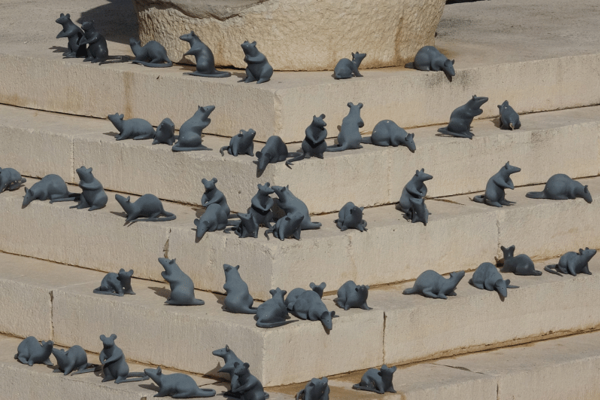Mice welcome visitors at Temple of Apollo Smintheus
ÇANAKKALE


Mice welcome visitors to the Temple of Apollo Smintheus, located in the northwestern province of Çanakkale’s Ayvacık district. The mouse figures that were placed on some of the steps of the temple in 2018 refer to an old belief in mythology.
The 79 mouse models are made of polyester and rumored to have lived there 2,000 years ago. Visitors have the opportunity to see all the figures of an old mythological story during their journey to the temple.
Excavation and restoration work, which started in 1980 at the Temple of Apollo Smintheus in the Gülpınar village, were carried out last year in the areas of archaeology, art history, epigraphy, architecture, anthropology, restoration-conservation and geophysics, Under the direction of Associated Professor Davut Kaplan of Samsun Ondokuz Mayıs University Department of Archeology, works was carried out with a team of nearly 20 people, consisting of experts and students from different branches of science such as geophysics.
During the excavations in the necropolis (cemetery) area in the northwest of the temple, in addition to two graves, foundation remains of some buildings were unearthed. Georadar studies were also carried out to reveal the archaeological potential in the excavation area.
The mouse figures, which were placed on some of the steps in the Temple of Apollo Smintheus in 2018 in accordance with the concept of the structure, attract a lot of attention by visitors. They are the products of an old belief in mythology.
The Apollon Smintheus Temple is located in the Bahçeleriçi area, in a valley between the northwest and northeast of the Gülpınar village.
It was built in the second half of the second century B.C., as a sacred place in the Troas region. Architect Hermogenes designed the temple using the pseudo dipteral style. The temple contains three chambers, including a pronaos (sacred front chamber), a naos (sacred room) and an opisthodomos (back chamber), as well as the statue of Apollo made by the sculptor Scopas.
According to the belief, the god Apollo protects farmers from mice and keeps them away from diseases. The Temple of Apollo Smintheus is his most important sanctuary in this region. It is the only example among the known Apollon cults in Anatolia that features a mouse symbol.
One of the most striking features of the Temple of Apollo Smintheus is that it has columns with reliefs depicting the Trojan War described in Homer's “Iliad” epic. Today, it is possible to see some of these relief columns depicting some of the events of the Trojan War in a small exhibition hall right next to the temple.
Stating that mice are important for the Temple of Apollo Smintheus, deputy head of the excavations, Associated Professor Oğuz Koçyiğit explained the following:
“We know that Smintheus has been one of the important cults of Apollo since ancient times. Apollon Smintheus means ‘Lord of the Mice.’ Rats are the focus of this cult. Because, according to the belief in ancient times, mice caused great harm to farmers. The people of the region made offerings to the god Apollo to get rid of these mice. Again, according to belief, the god Apollo killed these mice that destroyed crops and harmed people with his arrows. It has such a simple story, but one of the important cults of Apollo is Smintheus. Referring to this myth, the mice greet the visitors in the temple.”
